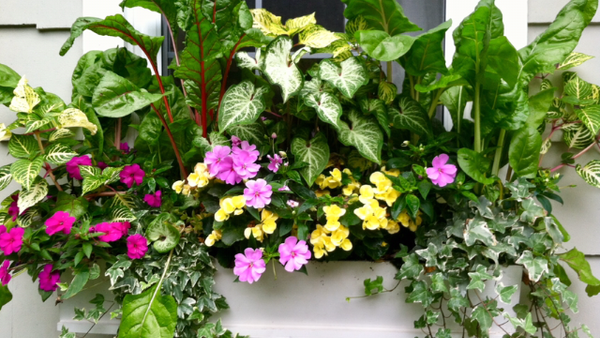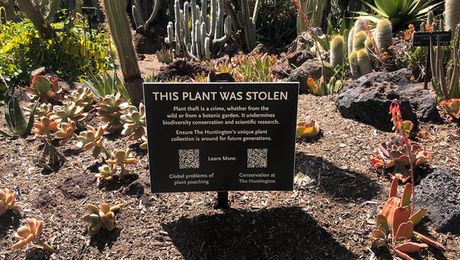My name is Barb Mrgich. I am a Master Gardener in Adams County, Pennsylvania, which is in Zone 6a.
My husband and I bought our 3/8-acre lot in 1989. The lot was nearly barren of even weeds. After we built the house, I started planting and have virtually never stopped. I am a strong believer in organic gardening. I make a lot of compost, and we never bag our grass or leaves. My garden is certified as a wildlife habitat by the National Wildlife Association, and as pollinator friendly by Penn State. I use as many native plants as I can but do not restrict myself to them.
This picture shows part of my pollinator garden. A large swath of Monarda
(bee balm) dominates this area. Echinacea purpurea
(purple coneflower), a yellow perennial Helianthus
(sunflower), white Shasta daisies ‘Becky’ (Leucanthemum × superbum
‘Becky’ Zones 5–9), and a variety of native mountain mint (Pycnanthemum muticum,
Zones 4–8) fill in a good bit of real estate. Behind the bee balm, a swamp milkweed (Asclepias incarnata,
Zones 3–6) has just finished blooming.
Our entire property slopes toward the street. In order to stop stormwater runoff, and to solve a dangerous mowing situation, I built this retaining wall 17 years ago. Starting to the left is a purple baptisia (Baptisia australis,
Zones 4–8) that has just finished blooming and now looks like a large shrub. It is a native plant. I bought it at a community center yard sale, and the helpful Boy Scouts had labeled it as a Purple Baptist! The small-sized Hydrangea paniculata
‘Dhruma’ (Zones 3–7) were difficult to find. They are now at their mature height of 3 to 4 feet. The small yellow bushes are Caryopteris
‘Sunshine Blue’ (Zones 5–9) and will cover themselves with blue flowers in August. The tall “tree lilies” are beautiful, but they don’t last too long.
In early June our garden was featured on a garden tour, and we had about 150 people come through. In addition to small ID labels on most of my plants, I used 10 of these signs to describe what was going on in the bed. This is a native milkweed (Asclepius tuberosa,
Zones 3–9) that the monarchs love along with many other pollinators. Strutting its stuff behind the brass headboard is Deutzia
‘Chardonnay Pearls’ (Zones 5–8), which remains bright yellow all season.
Clematis is always a popular vine. The big ones create privacy on a large trellis. Here the purple ‘Jackmanii’ contrasts nicely with the white ‘Corinne’, which I chose for its color and short size.
Another favorite clematis, ‘Betty Corning’, blooms all summer if you keep it watered.
More of the Deutzia
‘Chardonnay Pearls’ contrasting nicely with nine bark ‘Summer Wine’ (Physocarpus opulifolius,
Zones 2–9).
A lovely combination: bellflowers (Campanula glomerata
‘Superba’, Zones 3–8) beside old-fashioned peonies.
The beautiful and interesting flower of the eastern sweetshrub (Calycanthus floridus,
Zones 4–9), a shrub native to the eastern United States.
A monarch and an eastern swallowtail butterfly in the same picture. The plant that draws them is Tithonia
(Mexican sunflower, annual).
Have a garden you’d like to share?
Have photos to share? We’d love to see your garden, a particular collection of plants you love, or a wonderful garden you had the chance to visit!
To submit, send 5-10 photos to [email protected] along with some information about the plants in the pictures and where you took the photos. We’d love to hear where you are located, how long you’ve been gardening, successes you are proud of, failures you learned from, hopes for the future, favorite plants, or funny stories from your garden.
If you want to send photos in separate emails to the GPOD email box that is just fine.
Have a mobile phone? Tag your photos on Facebook, Instagram or Twitter with #FineGardening!
You don’t have to be a professional garden photographer – check out our garden photography tips!
Do you receive the GPOD by email yet? Sign up here.
Fine Gardening Recommended Products
A.M. Leonard Deluxe Soil Knife & Leather Sheath Combo
Fine Gardening receives a commission for items purchased through links on this site, including Amazon Associates and other affiliate advertising programs.
MULTITASKING DUAL EDGES: a deep serrated edge and a tapered slicing edge ideal for tough or delicate cuts. DURABLE 6-inch stainless steel blade withstands 300 lbs of pressure. TWINE CUTTING NOTCH, DEPTH GAUGE MARKINGS & spear point - no need to switch tools when using this garden knife. LEATHER SHEATH: heavy duty, protective, clip on sheath to keep your knife convenient and secure. LIFETIME WARRANTY.





























Comments
Thanks for posting what looks like a masterful garden, Barb.
I always enjoy seeing lush masses of perennials rather than busier planting strategies [which I've recently heard described as "one-of-eachy"]. I am sure the pollinators appreciate lots to do without flying off to new territory.
You sure have come a long way from a barren parcel of land. Congratulations!
Wow! Your gardens are gorgeous. A real feast for the eyes as well as the lucky pollinators that call your place home.
So many things you have that I love & grow myself - calycanthus, tree lilies, Tithonia, and Asclepius tuberosa. But I have to say in your zone, yours all look so much better than mine do right now. I am zone 8b with my toes right at zone 9. We have had an extremely dry summer with many plants dropping brown leaves. I was excited to find articles you have written on line. I am sharing the link for those who might be interested in reading them. https://www.emmitsburg.net/gardens/authors.htm#Barb%20Mrgich
Treasuresmom...thanks for sharing that link with us! -Sue
I love the masses of plantings and kudos to you for being so pollinator-friendly. I'm changing my borders up to do more massed plantings - I have all the plants needed but just need to get them all together (they showed up sort of higgledy-piggledy so I put them where I could). Gorgeous gardens like yours are an excellent inspiration! Thanks for sharing.
I can see you have truly learned from hard work and years of personal experience in your amazing garden! You didn't need a so called Master Gardener course at all! The link of garden articles you have written that Treasuresmom shared is some good info, and I will be reading them! Love your garden, thanks for sharing!!
Wow!!! This is an amazing garden! Love the Purple Baptist label. : ). The Betty Corning clematis is so lovely.
I've already done some reading from the articles on the master gardeners site that you have written - Silphium is one of my favorites, and I'm glad to discover how to contain it - it is trying to overtake my viburnum! Your pictures are lovely, your gardens are an inspiration - thanks for sharing your knowledge and artistry so freely.
Such a feast for the eyes! Thanks for sharing your beautiful garden with us!
Log in or create an account to post a comment.
Sign up Log in